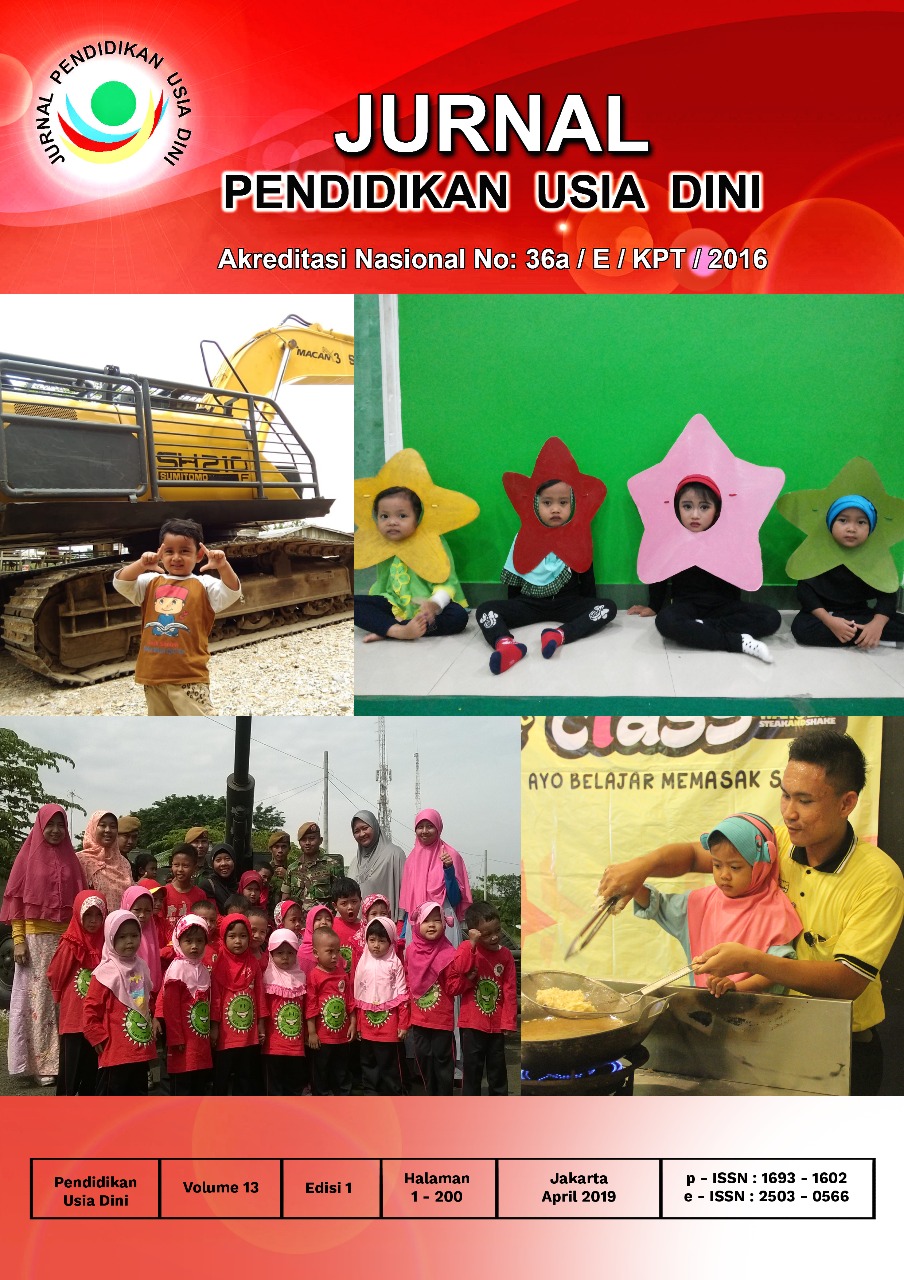Syntactic Analysis of Language Acquisition in Three-Year-Old Children Based on Cultural Background
DOI:
https://doi.org/10.21009/10.21009/JPUD.131.05Abstract
The variety of languages and cultures in the community will indirectly affect the acquisition and development of children's language. This will be seen when children change residence, where new dwellings, different variations or dialects. At the PAUD Nusantara University School Laboratory PGRI Kediri, most children from various regions, they are migrant fami-lies in the city of Kediri and need adaptation in the new environment including the language. This study uses a qualitative descriptive approach, the purpose of which is to describe the acquisition of language of three-year-olds in terms of cultural background and to describe the average length of speech of three-year-olds based on Mean Length of Utterance (MLU). The research subjects were four children from Tulungagung, Kediri, Malang and Surabaya. The results of speech analysis show that the average research subjects from Tulungagung, Ma-lang, Kediri and Surabaya had an average MLU of 2.92 in stage VI, which meant that they were still at a low stage, which at the age of three was already at the stage VII 3.0-3.5 words per speech. Based on the results of the analysis, it is recommended that teachers and parents improve stimulation and find appropriate strategies for the acquisition and development of children's language.
Keywords: Acquisition of children's language, Cultural background, Syntax Analysis
References
Bachri, C., & Maya, R. (2012). Pemerolehan Bahasa Anak Usia 7 Tahun 3 Bulan dalam bidang Sintaksis. Jurnal Edukasi Kultural.
Chaer, A. (2003). Psikolinguistik: Kajian Teoritik. Jakarta: PT Rineka Cipta.
Chaer, A., & Agustina, L. (2004). Sosiolinguistik Perkenalan Awal. Jakarta: PT Rineka Cipta.
Chater, N., & Christianshen, H. M. (2018). Language acquisition as skill learning. Behavioral Science.
Creswell, J. C. (2012). Introduction to Research Methods in Education. Los Angeles: Sage Publication.
Darjowidjojo, S. (2010). Psikolinguistik (Pengatar Pemahaman Bahasa Manusia). Jakarta: Yayasan Obor Indonesia.
Hakim, U. (2016). Studi Pemerolehan Bahasa pada Anak Usia 4 tahun (Kajian Sintaksis). Jurnal Linguistik Terapan.
Hetherington, P. (2003). Psikologi Perkembangan Anak dan Remaja Terjemahan Soemitro. Jakarta: Universitas Indonesia.
Hutabarat, I. (2018). Pemerolehan Sintaksis Bahasa Indonesia Anak Usia Dua Tahun Dan Tiga Tahun Di Padang Bulan. Jurnal Dharma Agung, Xxvi(1).
Mahsun. (2005). Metode Penelitian Bahasa. Jakarta: PT Raja Grafindo Persada.
Moleong, L. (2007). Metodologi Penelitian Kualitatif. Yogyakarta: PT Remaja Rosdakarya.
Nurjamiaty. (2015). Pemerolehan Bahasa Anak Usia Tiga Tahun Berdasarkan Tontonan Kesukaannya Ditinjau Dari Kontruksi Semantik. Jurnal Edukasi Kultura, 2(2).
Owens, R. G. (2008). Organizational Behavior in Education (4th Ed) III. New York: Allyn&Bacon.
Rahardi, K. (2001). Sosiolinguistik, Kode, dan Alih Kode. Yogyakarta: Pustaka Pelajar.
Roni, N. S. (2016). Panjang Rata-Rata Tuturan Anak Usia 2 Tahun 7 Bulan Dalam Bingkai Teori Pemerolehan Bahasa Anak. Jurnal Pendidikan2016.
Salnita, Y. E., Atmazaki, & Abdurrahman. (2019). Language Acquisition for Early Childhood. Jurnal Obsesi, 3(1).
Smith, A. (2010). Development of Vocabularry and Grammar in Young America Speaking Children Assessed with aAmerica Language Development Inventory.
Sumarsono. (2013). Sosiolinguistik. Yogyakarta: Pustaka Pelajar.
Sumarsono, & Partana, P. (2018). Sosiolinguistik. Yogyakarta: Pustaka Pelajar.
Vissiennon, K., Friederic, A. D., Brauer, J., & Wu, C.-Y. (2016). Functional organization of the language network in three- and six-year-old children. Neuropsychologia.
Downloads
Published
How to Cite
Issue
Section
License
JURNAL PENDIDIKAN USIA DINI work is licensed under a Creative Commons Attribution 4.0 International License. (http://creativecommons.org/licenses/by/4.0/)





